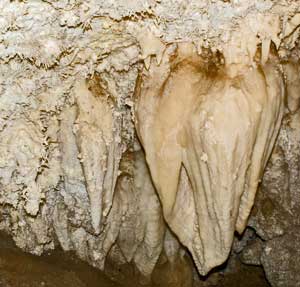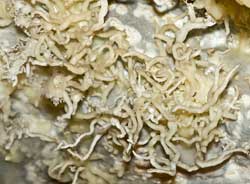 |
| Heart of Timpanogos. |
Timpanogos Cave National Monument, Utah
High on the steep rocky slopes of American Fork Canyon in the shadow of mighty Mount Timpanogos in Utah's Wasatch Range are three moderate-sized limestone caves: Hansen Cave, Middle Cave, and Timpanogos Cave. These exquisitely beautiful caverns are decorated with a dazzling display of helictites and anthodites in a variety of fantastic shapes. In the tradition of the National Park Service, Timpanogos Cave National Monument preserves these caves and all their fragile underground wonders for you, and for others in the years ahead, to enjoy.
Underground Delights
Some of the earth's most powerful and most delicate forces combined to create the wonders of Hansen, Middle, and Timpanogos caves beginning when the Wasatch Range was building 65 million years ago. Tremendous mountain-building forces slowly uplifted and fractured the sedimentary rock. The caves were dissolved later along fractures now called the Hansen, Middle, and Timpanogos faults in the Deseret Limestone. Apparently rising hot water and descending cold water were important factors in the caves' origins. Natural, weak carbonic acid dissolved the rock to form the caves, which were created at the level of an ancient water table and later invaded by a stream for a short time. It is likely that rainwater and water from melting snows seeped or flowed underground along two vertical cracks (or faults) dissolved the surrounding layer of Deseret Limestone, and hollowed out the subterranean chambers.Then a change occurred. Water that filled or partially filled the caves drained. As water seeped into the air-filled caves, it decorated them with fantastic formations. Water trickling through the limestone overlying the caves dissolved calcite and other minerals from the rock. Then, upon entering an underground chamber, the water deposited its mineral load as a tiny crystal on a cave ceiling, wall, or floor. Over thousands of years, as countless crystals were deposited, a variety of cave formations took shape - stalactites, stalagmites, flowstone, helictites, and others. Each had its own shape and size, determined by how and where the water entered the cave, how long it flowed, and other factors.
Today, the caves still are changing: new formations are being created, and existing ones are growing where mineral-laden water continues to enter. In Timpanogos Cave a stalactite-stalagmite pair are growing closer year by year; today they are only 3/4 of an inch apart, and if growth continues at the current rate, they probably will join in about 200 years. As long as water - the master architect and interior decorator - continues to trickle into the caves, creation will continue.
 |
| Helictites. |
Helictites: Stars of the Underground Show
Helictite, a strange and exotic sounding word, is the name of a strange type of cave formation found in these caves. The tremendous number of helictites is one of the things that makes the Timpanogos Cave system so special. Such quantities of helictites, coupled with anthodites, are uncommon. Helictites twist and turn unpredictably in all directions, defying gravity. Usually less than 1/4 inch in diameter and a few inches long, they are as delicate - and fragile - as hand-blown glass.Smooth but spiraling helictites are made of calcite; needle-like crystals are made of aragonite, a mineral chemically identical to calcite but with a different crystal structure.
Cave explorers and speleologists have debated the origin of helictites since they were first discovered. From the beginning it was apparently understood that they were created in a much different way from such formations as stalactites, stalagmites, and other more common formations. Some early speculators believed helictites were created by mineral deposits on spider webs or fungi. Some thought their odd contortions were the result of the forces of electrical energy, cave winds, or earth tremors.
Today many speleologists believe that two forces peculiar to water guide the creation of helictites. Like crooked straws, most helictites appear to have a tiny central canal running up and down their length. Water is apparently pushed and pulled through this canal by capillary action under hydrostatic pressure. Together these two forces override the usually dominant force of gravity: controlled by these forces water slowly seeps through the canal to the tip of the helictite where it then deposits a crystal. Some scientists further believe that the crystals do not stack neatly, but arrange themselves haphazardly one on top of the other, adding to the apparently random nature of their growth. Future research may shed new light on these unusual cave creations.
Stalactites and Other Common Cave Formations
Many different types of cave formations have been created by water simply dripping or flowing into the caves. Perhaps the most well known of these are stalactites and stalagmites, which can be seen throughout the caves. Stalactites, which hang like icicles from the ceiling, form as drop after drop of water slowly trickles down through the cave roof. The smallest stalactites may be hollow and as thin and straight as a soda straw, and so are called soda straw stalactites. Others may be massive: The Great Heart of Timpanogos in Timpanogos Cave - 5 1/4 feet long, 3 feet wide, 4,000 pounds - is composed of three, or possibly more, tremendous stalactites that have grown together. The many colors of stalactites - and indeed all of the formations in the caves - are caused by traces of iron, nickel, magnesium, and organics. Stalagmites are formed when mineral-laden water strikes the floor. The tallest stalagmite is about six feet high in Timpanogos Cave; most are smaller. Occasionally stalagmites and stalactites merge, forming a floor-to-ceiling column. The caves' largest column, 13 feet high, is found in Hansen Cave.Another common formation - draperies - are created when water trickles down an inclined ceiling. A spectacular example of such a formation is the Frozen Sunbeam, a thin translucent sheet of orange-colored calcite in Timpanogos Cave. Draperies in these caves are seldom more than one inch thick.
The Cascade of Energy and the Chocolate Fountain, both in Timpanogos Cave, are examples of still a different type of formation - flowstone. As its name implies, the smooth coatings or sculpted terraces of flowstone are created when water flows down a wall or across a floor. A particularly impressive specimen decorates a wall in the Big Room of Mid.e Cave.
Still another, not quite so common type of formation that occurs in the caves is cave popcorn. Popcorn occurs where water seeps slowly through walls or ceilings. These knobby lumps are particularly abundant in Timpanogos Cave, where they occur mixed with helictites.
Underground Pools and Cave Creatures
The caves natural world offers many other features besides unusual crystal formations. Small, clear pools occur where water has collected; mirror-like, they reflect their other-worldly surroundings. There are 30 such pools and lakes in the Timpanogos Cave System. One pool, Hidden Lake, can be seen in Timpanogos Cave. A lake in Hansen Cave, not visible along the cave tour route, supplies drinking water for the fountain at the Grotto. In some pools, small wall-like formations made of calcite form rimstone dams.Animals inhabit the caves, but they can be easy to overlook. Such barely noticeable creatures as cave spiders, centipedes, and crickets live here. An occasional bat roosts in the caves, but no large bat colony such as those found in Carlsbad Caverns or in many other caves exist here. Occasionally a pack rat, mouse, chipmunk, or lizard visits. Without an underground stream or other steady source of food, however, the caves are not well equipped to support a diversity of cave animals.
Like other cave features, the pools and cave animals are protected by the National Park Service. Their survival depends on the Park Service and on you.